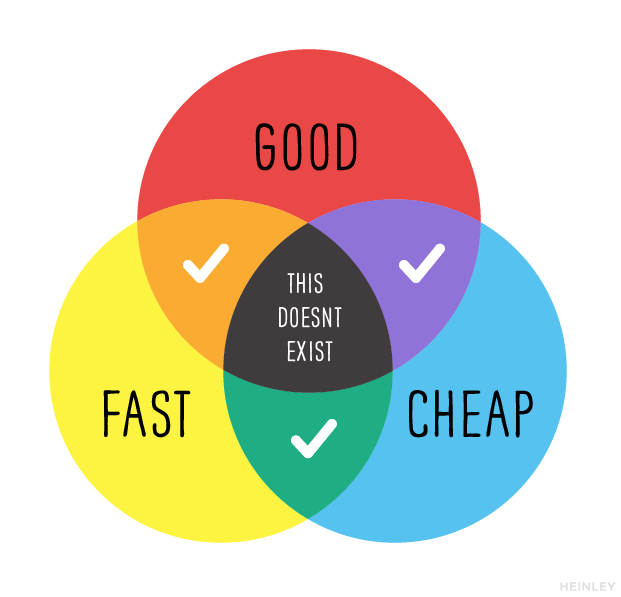Understanding the good/cheap/fast of content marketing and SEO.
There’s an old truism in marketing and other customer service-related fields that you can have quality, efficiency, or cost, but not all three.

Good, fast, cheap: pick two.
It’s a broadly-accurate statement that applies in all sorts of conditions, and content marketing and SEO are no exceptions.
Of course, that doesn’t keep clients from asking. And that’s not entirely their fault: you can’t blame someone for unrealistic expectations if they have no context for understanding what is or isn’t normal. Not to mention that each of these qualities are subjective, and what my seem cheap for one person may seem exorbitant to another.
And then the Internet complicates everything by providing so many conflicting takes on what is or isn’t doable that it’s easy to be misled.
Unfortunately, because they’re such new fields, SEO and content marketing are prime targets for misleading information and false promises. It’s all too easy to find purported SEO specialists selling snake oil instead of real solutions. And when businesses fall victim to bad SEO advice, it tarnishes the field’s good name.
SEO and content marketing have a lot to offer businesses, but only when they’re done right. Here’s how we break that down for you.
Good + Cheap = Blogging.
SEO involves a lot more than blogging, but if you want to witness the fruits of your strategy unfold, you need content on your website that will attract your audience. This is what blogging provides, and it’s one of the most effective SEO strategies at your disposal.
And, for the returns you get in traffic volume, it’s hard to beat. Yes, it still costs money. And as we said before: cost is relative. Spending thousands of dollars over the course of a year may be your entire marketing budget, or it could be the amount you spend on AdWords in a week. But for most businesses, blogging is a modest marketing investment that can return steep dividends.
More importantly, blogs have staying power. If you write a blog and it starts to rank, that single blog post can continue drawing in organic search traffic for years to come. It doesn’t just disappear after you publish it.
That said, it takes time for blogs to begin ranking in organic results—usually about six months or so. Like exercise, you can’t expect to see results overnight. You have to keep working at it, and the cumulative effect of blogging over time will draw in the business you need.
Good + Fast = Targeted Advertising.
At this point, you might be thinking: Hold up, what does targeted advertising have to do with SEO? Isn’t that advertising and not content marketing?
And you’d be right. While all good advertising pays attention to audience demographics and target personas, it’s going to be bringing in paid rather than organic search traffic.
The reason why you can have it fast is because you’re promoting it. But your promotions can still be for content marketing pieces. If you’ve recently written a killer e-book describing your products and services and how they can help businesses succeed—well, why not put some ad spend behind it? You will be able to track who downloads your materials, then use your email workflows to convert those leads to customers.
Or you can use your ad money differently. The point is, it will be expensive, and it will be ongoing. When advertising doesn’t have content to back it, there can be no longevity to the campaign. Stop running the ads, and the campaign ends.
Because of this, it’s best if you can combine it with blogging. That will give you the best of both worlds: Immediate results backed by steady content generation that’s sure to build your SEO.
Cheap + Fast = Black Hat.
In SEO, cheap and fast aren’t just low quality, they’re actually damaging to your business. These bad SEO tactics—commonly referred to as “black hat” SEO—usually involve a promise of immediate results for a nominal sum that seems almost too good to be true (because it is).
For instance, black hat practices include tactics such as keyword stuffing, where they hide keywords in places where the users aren’t likely to notice (such as alt tags or white text on white background), but where they will get picked up by Google. Or they offer to purchase backlinks for your site, giving it the superficial impression of having a lot of credible and valuable content, when really the backlinks all come from bad domain sources.
These tactics are based on manipulating ranking factors to rig the system in your favor. If that sounds dodgy, that’s because it is. It’s not just bad SEO—it’s bad business.
Google strongly penalizes these tactics if they catch them—as is their right. Google doesn’t owe you rankings. In fact, if you do things to unfairly skew rankings in your favor, you’re damaging the integrity of the product Google offers (which is fast and relevant search results).
More importantly, by rigging the system you’re trying to punch above your weight. Because you haven’t done the background SEO work to have fairly earned your rankings, you’re not going to have the product or services that your visitors want. You may temporarily outrank some of your competition, but when your visitors don’t find what they’re looking for, they’ll bounce.
You really can only pick two.
If at this point you’re asking “why can’t I have good marketing that delivers fast results and doesn’t cost an arm and a leg?” the answer is simple: you’re asking the impossible. No self-respecting marketer or SEO specialist is going to promise results they can’t deliver—and if they do deliver them, it won’t be cheap.
So if you don’t have six months to watch your content marketing strategy start to pay off, and you don’t have the budget to boost it along with paid advertising, none of this is going to work for you.
But, if you have one of those two things (time or budget), then content marketing combined with good SEO and a well-executed advertising campaign can draw traffic to your site, build leads, and convert sales.
It may not be cheap, or it may not be fast. But it will always be good.







